The John Charles Meditz College of Arts and Sciences encourages undergraduate students from all disciplines to conduct innovative, in-depth, and collaborative research under the guidance and encouragement of faculty experts and staff.
Undergraduate Research
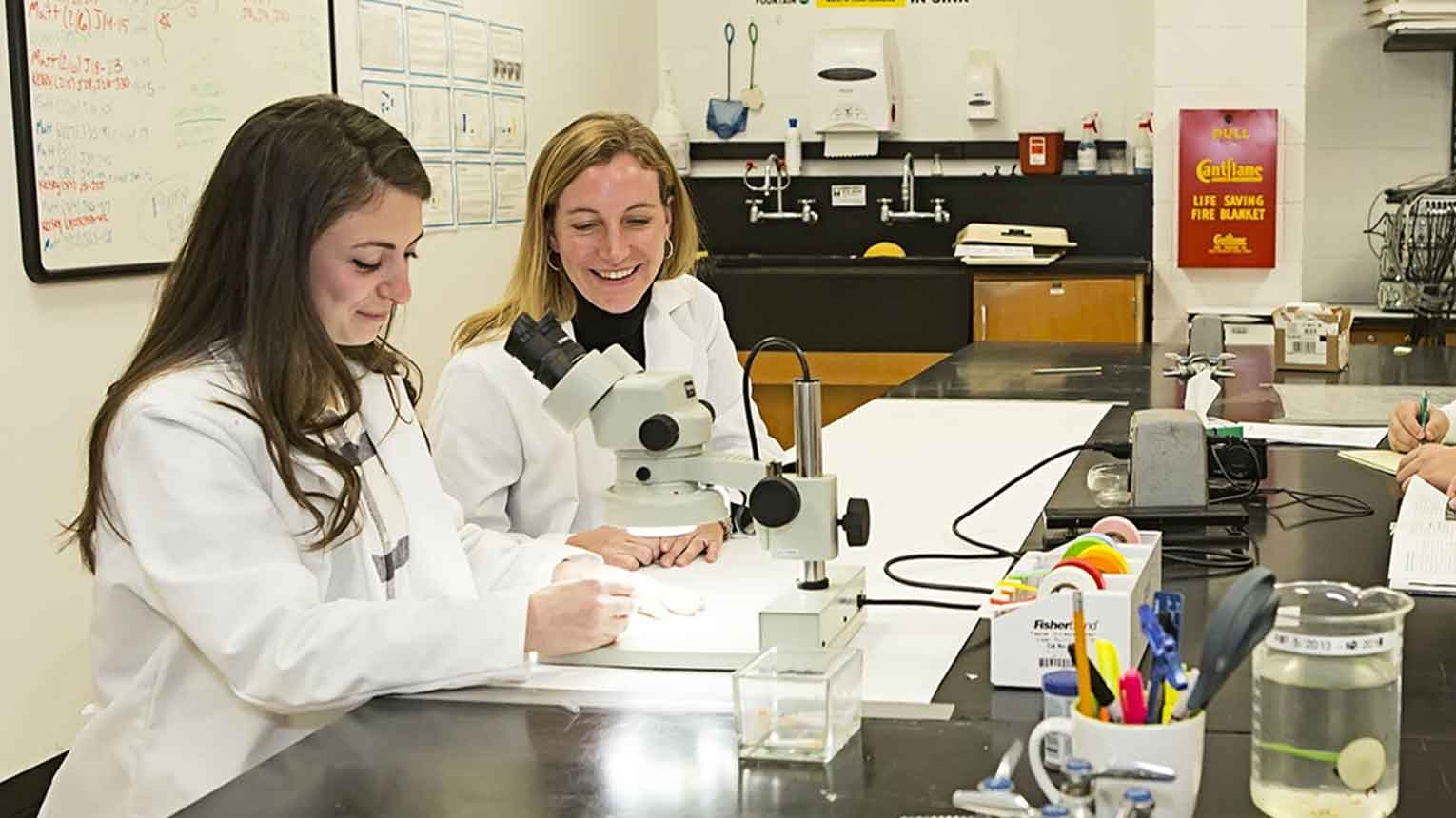
Be on the cutting edge
Each year, more than 300 faculty-student research projects are conducted in the areas of STEM (science, technology, engineering, and mathematics), the humanities, arts, and social sciences, more than half of which are presented at national scholarly meetings and/or published in professional journals and manuscripts.
The research conducted within the Meditz College of Arts and Sciences provides undergraduate students the opportunity for faculty mentorship, active learning, and the ability to discover new knowledge while being challenged in new ways. With research being conducted across multiple disciplines, students can join or develop original research projects that allow them to explore their passions while developing important industry connections and making invaluable contributions to their field of study.
Recent Research Projects
Chelsie Counsell, PhD, assistant professor of biology, has been researching coral reefs and marine communities for over a decade. Her research asks questions about how marine ecosystems vary through space and over time. Much of her work has focused on human inputs on reef ecosystem health.
Dr. Counsell enlisted two undergraduate student research assistants: Rebecca Buonopane ’22 and Jillian Ryan ’22. Both seniors applied for University-funded grants to support their trip to Hawaii, during which they stayed in dormitories on Coconut Island — a private research lab only accessible by boat — for a month during the summer of 2020.
“It’s rigorous and admirable,” Ryan said of the research that Dr. Counsell and her colleagues embarked on in the field, in the lab, and “behind the scenes.”
Frances L. Forrest, PhD, assistant professor of sociology and anthropology at Fairfield was part of an international team that uncovered a trove of three-million-year-old stone tools, fossils, animal and hominin teeth at Nyayanga — an archaeological site in Kenya — which turned out to be the earliest evidence of a species using stone chopping, scraping, and cutting implements, nearly a million years earlier than previously documented.
This research by Dr. Forrest was featured among Smithsonian Magazine’s most fascinating findings of 2023.
Physics majors Christian Burns ’20 and Jordan Hamilton ’22 participated in a summer-long research study alongside Assistant Physics Professor Robert Nazarian, PhD, on the global impacts of ocean mixing in submarine canyons. Often tens of miles long, submarine canyons are suggested to be regions of intense ocean mixing, a process that is responsible for sustaining the ocean’s circulation, as well as the global climate system.
Utilizing a high-resolution ocean topography map and computational model for energy fluxes to calculate the total amount of ocean mixing occurring in submarine canyons located along the continental shelf, the researchers set out to determine the total amount of energy that is lost in marine canyons as a result of this mixing.
Scientists from Fairfield University and Scripps Institution of Oceanography at UC San Diego investigated projected precipitation trends over northern Mexico. They found that the frequency of extreme precipitation events is expected to double throughout the region, exacerbating the flood risk for vulnerable communities there.
Using high-resolution climate model simulations tested against observations, the study found that these hydroclimate extremes will likely be exacerbated in a warming climate. Drought seasons are projected to receive significantly less precipitation and flood seasons significantly more (roughly 10 percent) by the end of the century.
2025 Fairfield University Student Research Symposium
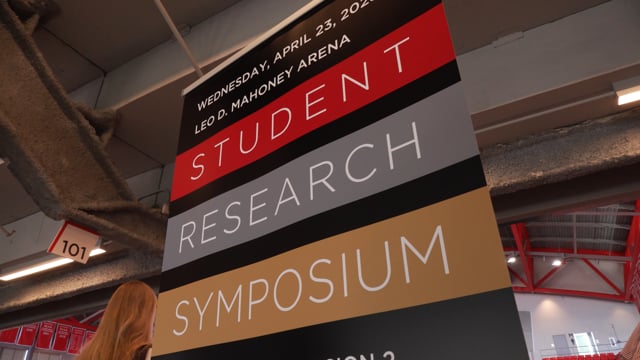
‘Spanish my first language,/bachata a reminder of the power of my body’; Exploring YA Texts for Spanish-Speaking Students.”
– Max Limric ‘25
Past Research and Grants
Dr. Catherine J. Anderson and Dr. Aaron Van Dyke lead research students in groundbreaking nutritional science study.
The United States Department of Agriculture’s National Institute of Food and Agriculture (USDA-NIFA) has awarded Fairfield University's assistant biology professor Catherine J. Andersen, PhD, with a $149,419 federal grant to support an innovative faculty-student research study in the area of nutritional sciences. Aaron Van Dyke, assistant professor of chemistry and biochemistry, will join Dr. Andersen as the study’s co-project director.
The two-year research project will investigate the effects of dietary intake on markers of cholesterol metabolism, inflammation, and immune function. As part of the study, healthy adults will participate in a dietary intervention trial to determine whether whole eggs, egg whites, or an egg-free diet can alter the beneficial properties of HDL – carriers of the “good cholesterol” – in the bloodstream. Fairfield’s researchers hope to determine if the bioactive components in the egg yolks will alter the composition and function of HDL, leading to beneficial changes in immune cell activity and inflammation. Their findings could have important implications for the role of nutrition in health and human disease.
Each semester, a total of four to six undergraduate research students from both Dr. Andersen's and Dr. Van Dyke’s labs will conduct experiments and perform data analysis for the study. Research activities will include comprehensive dietary evaluation, cell culture work, molecular biology assays, and biochemical analysis. Fairfield University is uniquely equipped for this research, thanks in part to a $271,407 instrumentation grant from the National Science Foundation (NSF) which Dr. Andersen and Dr. Van Dyke helped secure.
Through the study’s collaborative and interdisciplinary approach to nutritional sciences, both Dr. Andersen and Dr. Van Dyke hope to develop exciting new lab techniques that can be applied to future research projects. “By working together we are able to leverage our expertise in nutritional sciences, molecular biology, and chemical biology to address novel research questions,” Dr. Andersen stated. “This grant serves as evidence that our work is competitive in the national arena, allowing us to continue developing our research programs in exciting new areas.”
“Asking scholars to reach beyond the boundaries of their own field is built into the DNA of Jesuit institutions,” said Dr. Van Dyke. “This grant offers further external validation that our student-faculty research teams are among the best nationally.”
Professors Angela Biselli, PhD, and John Miecznikowski, PhD, will spearhead new initiatives to engage undergraduate students in cutting-edge research experiences.
The National Science Foundation has awarded the College of Arts and Sciences School of Natural and Behavioral Sciences and Mathematics at Fairfield University with more than $450,000 in grant funding to support faculty-student research initiatives in the fields of chemistry, biochemistry, and physics.
Physics professor Angela Biselli, PhD, was recently awarded a $148,413 grant for a three-year research study on the fundamental structure of protons and neutrons. The study, which will be conducted in collaboration with the Thomas Jefferson National Accelerator Facility in Virginia, will examine how quarks, the sub-particles of protons and neutrons, directly affect the particles’ macroscopic properties.
Throughout the study, Dr. Biselli will travel to Jefferson Lab, where she and her fellow researchers will take shifts running experiments and analyzing findings that will impact scientists’ fundamental knowledge of what matter is made of. The professor’s undergraduate students will participate in weekly virtual meetings with the research collaborators at Jefferson Lab, as well as travel to the facility during the summer, affording them the unique opportunity to gain knowledge in nuclear and particle physics, obtain practical experience in data analysis, and develop broader skills such as coding and statistics.
“I am deeply honored to receive this grant and am happy I can share this opportunity to conduct research in a nuclear physics lab with our undergraduate students,” Dr. Biselli said. “Not all undergraduate institutions can offer this type of research to their students, and the skill sets they gain will be very valuable for any science/technology related job they have in the future.”
In addition to Dr. Biselli, associate professor of chemistry and biochemistry John Miecznikowski, PhD, with the support of his colleagues Matthew Kubasik, PhD, Jillian Smith-Carpenter, PhD, Aaron Van Dyke, PhD, and Lawrence K. Steffen, PhD, received a $306,950 Major Research Instrumentation grant from the National Science Foundation to acquire a Nuclear Magnetic Resonance (NMR) spectrometer for the Department of Chemistry and Biochemistry.
One of the most powerful tools available to chemists carrying out frontier research, the NMR spectrometer will be used by Fairfield chemistry and biochemistry faculty and students to identify unknown substances, characterize the arrangements of atoms within molecules, and study the dynamics of interactions between molecules in solution. The ability to carry out these experiments is essential to the study of biologically relevant species, as well as research studies that require the acceleration of chemical reactions.
Scheduled to arrive in May 2019, the 400 MHz NMR spectrometer will provide critical instrumental support for at least six faculty-student research groups, five of which originate from Fairfield University, and the sixth from a collaborative partnership with the Department of Chemistry at nearby Iona College. The instrument will also be used by Bridgeport high school students participating in the University’s Upward Bound and BASE Camp outreach programs.
Dr. Miecznikowski believes that this cutting-edge technology will help university students gain confidence in using the same scientific instruments utilized by chemists working in government laboratories, pharmaceutical and chemical companies, and top graduate schools around the world.
“Having advanced instrumentation on campus leads to more high-quality research opportunities, and prepares students for successful career and graduate program outcomes,” Dr. Miecznikowski said. “The acquisition of the NMR spectrometer will allow Fairfield University faculty and their collaborators to continue making frequent, scholarly contributions to the fields of chemistry and biochemistry.
Physics Professor Min Xu, PhD, and Biology Department Chair and Professor Shelley Phelan, PhD, lead students in innovative, three-year study on the growth and aggressiveness of cancer cells.
College of Arts and Sciences faculty members Min Xu, PhD, associate professor of physics and Shelley Phelan, PhD, professor and chair of the Biology Department, have been awarded a three-year, $238,000 grant from the National Science Foundation, to conduct an interdisciplinary study on the physical principles behind the growth and aggressiveness of cancer cells.
The innovative research project is scheduled to start at the end of the fall 2017 semester and will use microscopic imaging to determine whether or not it is possible to identify specific cell properties, such as nuclear structure or cellular metabolism, that control the rate of a cancer cell’s growth. If these factors can be identified, scientists would be able to predict cancer aggressiveness directly from cell imaging, which would provide breakthrough advances in cancer screening, diagnosis, and treatment.
“The determination of the aggressiveness of cancer is key in choosing the optimal treatment strategy for a patient,” explained Dr. Phelan, who also serves as the director of the College of Arts and Sciences School of Natural and Behavioral Sciences and Mathematics. “This method of predicting aggressiveness could provide new avenues in cancer diagnosis and prognosis, and would be especially helpful in treating cancers that are more difficult to diagnose with surgical or other invasive methods.”
Employing an interdisciplinary approach to research, the new study will be facilitated by motivated students enrolled in the University’s physics, biology, engineering, and other natural science departments. Dr. Xu and Dr. Phelan believe these multi-disciplinary perspectives allow for a unique point of intersection that is essential to understanding cancer biology.
“There are many researchers within the field who have traditional training in biology or chemistry, and while they have contributed to great progress, some of the most complex issues are not being addressed by single fields,” Phelan explained. “This is being seen in a wide variety of areas, and that is why diagnostics and therapies in the cancer field now include contributions from physics, engineering, and materials science.”
Dr. Xu's and Dr. Phelan’s upcoming study is just one of a large number of active research projects taking place on Fairfield’s campus. Faculty members within the natural science departments conduct research alongside undergraduates on a daily basis, providing them with the essential training needed to become the next generation of scientists and critical thinkers.
“The most exciting advances in science and technology are interdisciplinary nowadays,” said Dr. Xu. “Interdisciplinary research involving undergraduates offers these students training in broad skill sets and perspectives that are invaluable to their future careers.”
Existing work linking empathy with social behavior has focused overwhelmingly on empathy for the negative emotions of others. But recent research suggests that feeling along with others’ negative emotions is a capacity distinct from feeling along with others’ positive emotions. In Study 1, we demonstrate the separability of positive and negative empathy by showing that although both relate to some of the same foundational empathic processes, each has a number of distinct correlates. In Study 2 we take an experimental approach and show that encouraging participants to empathize with the positive versus negative emotions of a suffering yet hopeful social group results in distinct patterns of vicarious emotion. Finally, Study 3 shows that although both positive empathy and negative empathy are associated to a similar degree with helping behavior directed toward others in need, positive—but not negative—empathy is related to “everyday” prosocial behaviors aimed specifically at increasing others’ positive emotions (e.g., random acts of kindness). Together, these results provide what to our knowledge is the first demonstration of the causal potency of positive and negative empathy as well as the first evidence that positive and negative empathy relate to different types of social behaviors.
Read more about a journal published by students and faculty in Fairfield’s psychology department.
Vice Provost Jay Rozgonyi has been incredibly encouraging, enthusiastic, and supportive throughout the research project. The project would not have been possible without his immense support. Working with a faculty mentor has enabled me to explore a special interest that I may have not otherwise found if it were not for the opportunities I have been presented with while at the University."
– Taylor Soyland '24
The Arts & Sciences Guarantee
Real world. Real network. Beginning with the Class of 2026, the Arts & Sciences Guarantee is a fellowship open to all current Fairfield Meditz undergraduates, which provides funding of up to $2,500 to support approved unpaid internships, research, or fieldwork experiences.
For more information, please contact cascareers@fairfield.edu.
-
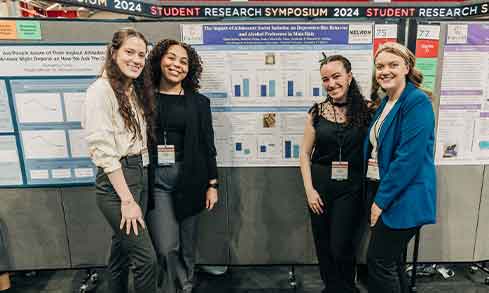
Research & Creative Accomplishments Symposium
Learn more about the celebration of groundbreaking student research, innovative thinking, and fresh ideas at Fairfield University’s Annual Research and Creative Accomplishments Symposium.
-
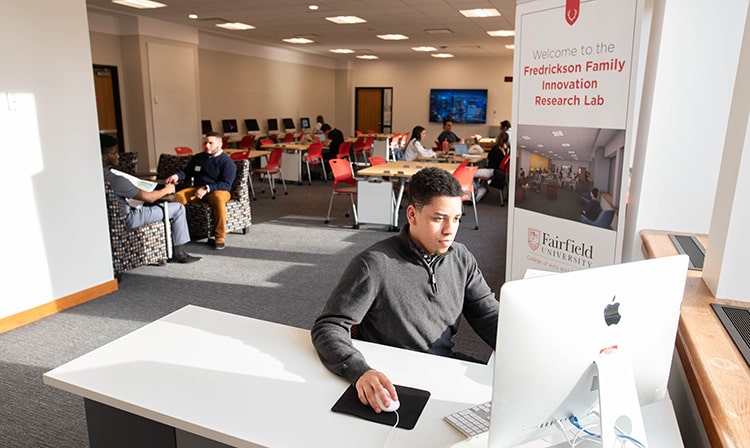
Frederickson Family Innovation Lab
Learn more about Fairfield’s gathering space for interdisciplinary research, instruction, and cross-pollination in the College of Arts and Sciences.
-
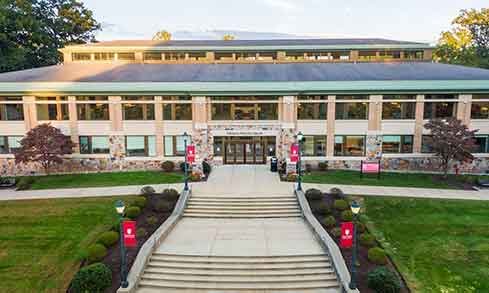
Digital Humanities Hub
View digital scholarship completed by University faculty and students across the humanities.

“Characterization of the Conductive Properties of Self-Assembling Peptides Including Tyrosine Amino Acids”

Faculty visiting students at the annual Student Research Symposium

“The Gender of Addiction: Janis Joplin, Stevie Nicks, and the Rock Music Industry”.

2024 Student Research Symposium in the Leo D. Mahoney Arena
